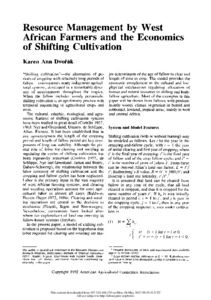| dc.description.abstract | "Shifting cultivation" - the alternation of periods of cropping with relatively long periods of fallow-encompasses many indigenous agricultural systems, developed in a remarkable diversity
of environments throughout the tropics. When the fallow includes woody perennials, shifting cultivation is an agroforestry practice with temporal sequencing of agricultural crops and trees.
The cultural, edaphic, ecological, and agronomic features of shifting cultivation systems have been studied in great detail (Conklin 1957, 1963; Nye and Greenland , Unesco, de Schlippe, Allan, Fresco). It has been established that in any agroecosystem the length of the cropping period and length of fallow period are key components of long-run stability. Although the pivotal role of labor for clearing and weeding in regulating the cycles of shifting cultivation has been repeatedly remarked (Conklin 1957, de Schlippe, Nye and Greenland , Jurion and Henry, Dabasi-Schweng) , the relationship between the labor economy of shifting cultivation and the cropping and fallow cycles has been neglected. Labor is the primary input in the vast majority of west African farming systems, and clearing and weeding operations account for most agricultural
labor in almost all cases (Baldwin; Fresco; Guyer 1972, 1984). Clearing and weeding operations are central to the decision to mechanize (Pingali, Bigot, and Binswanger). Nevertheless , economists have looked elsewhere for explanations of land-use intensity in fallow-based systems (Stryker).
In the present paper, a model of shifting cultivation is proposed based on the hypothesis that labor required for clearing and weeding are major determinants of the age of fallow to clear and length of time to crop. The model provides the economic complement to the cultural and biophysical mechanisms regulating allocation of human and natural resources in shifting and bushfallow agriculture . Most of the examples in this
paper will be drawn from fallows with predominantly woody climax vegetation in humid and subhumid, lowland, tropical areas, mainly in west and central Africa. |

